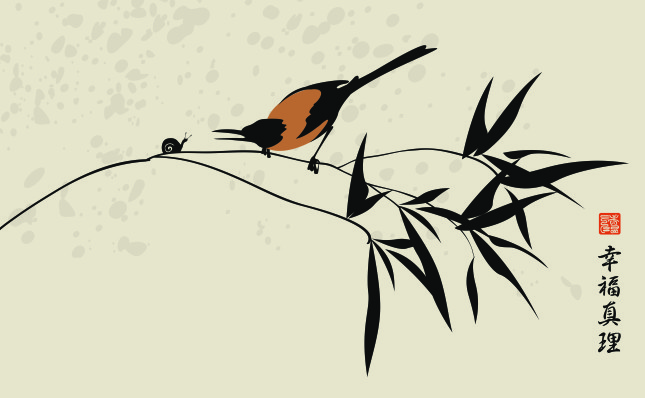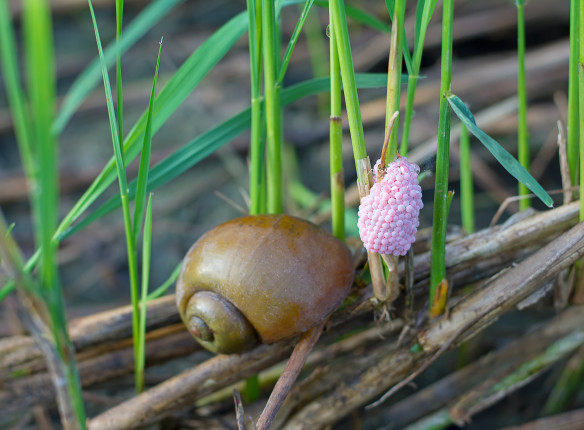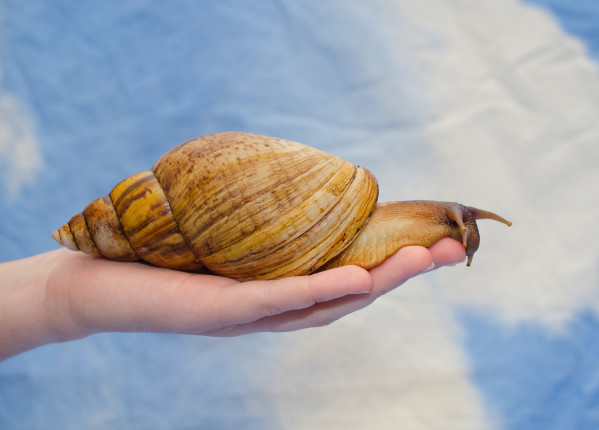-
A Tale of Two Snails: Biodiversity Threats of Invasive Species in the United States and China
May 27, 2021 By Karen ManclSpring is the best time to eat snails, when they are their plumpest, sweet and rich in protein. Snails have been slurped in China for centuries and are an inexpensive treat for a holiday celebration. In contrast to French escargot, which is served with butter and garlic, the Chinese eat snails in stir-fry, braised or boiled and eaten right from the shell. Not all snails are a treat, however, and unfortunately some are extremely damaging to crops and natural ecosystems when they are introduced into a non-native environment.
As host of the 15th Convention of Biological Diversity, China will be leading discussions where controlling invasive species is one of the key actions. Intentional introduction of exotic species has been a part of agriculture for centuries. Two recent examples are the North American crayfish taken to China as a profitable aquaculture species and Asian Carp brought to the U.S. to control algae in ponds—both became costly invasive species. The United States and China are the most likely sources of invasive species, and will likely suffer the most from their effects. The seemingly innocent introduction of snails, for example, has had disastrous impacts on agriculture production and income, human health, and ecosystem diversity.
The Not-So-Slow Apple Snail Invasion in China
The apple snail is an invasive species from South America brought to China in the 1980s for aquaculture. These snails are easy and inexpensive to grow, so entrepreneurial import companies marketed these “golden miracle snails” throughout China from Guangdong to as far north as Liaoning. Sadly, no one had done the market research, so Chinese farmers discovered the apple snail texture was too soft for consumers’ taste and just released the snails. As voracious eaters, the snails eat the roots of aquatic plants, like taro, lotus, water chestnut and especially rice plants. Apple snails also eat frog eggs and the eggs of other snails, threatening the native populations and ecosystems.
Damage to rice is a serious threat from apple snails causing annual losses in the Philippines of as much as $2 billion. With an infestation of just one snail every square meter, yield is reduced by 20 percent. Only 8 snails per square meter cause a devastating 90 percent yield reduction.
Controlling apple snails is a challenge. The snails mature within 2 to 3 months and lay up to 8,700 eggs per year. While time consuming, farmers can eradicate the threat by gathering the snails and their clusters of bright pink eggs. Farmers also use ducks as a biological control to eat snails. Besides not being tasty, human consumption of apple snails is not advised as they can carry rat lungworm which causes eosinophilic meningitis in humans. A pesticide is available to kill the snails, but it also kills other snails and shellfish.
The Expensive Giant African Snail Invasion in the United States
Snails have also invaded the United States. The giant African snail is one of the largest snails in the world, measuring up to 8 inches long and lives for 9 years. Smuggled into Florida by a young boy as pets in 1966, three giant African snails were released into a garden by his grandmother. The resulting infestation of more than 18,000 snails took 10 years and over $1 million to eradicate, preventing an estimated $11 million in crop losses. The giant snails eat at least 500 different plants and even the stucco on buildings.
Unfortunately, by 2011 giant African snails were back in Florida. A pair of snails produces 1,200 eggs per year, so the U.S. Department of Agriculture (USDA) considers them a top pest threat. By 2013, 128,000 snails were found and destroyed. The USDA has used trained Labrador Retrievers to track down hundreds of snails per week. New attractants have been developed from papaya-flavored oil to bait traps to capture the giant African snail.
China’s Policies Lag the U.S.
Chinese and U.S. customs officials are on the front lines looking for invasive species. Every year, Chinese customs intercepts thousands of batches of foreign pests, as do U.S. customs. In fact, just this year in New York, airport customs officials found 22 giant African snails in a Ghanaian man’s luggage.
Within the United States, the USDA Animal and Plant Health Inspection Service and the U.S. Fish and Wildlife Service regulate and ban the import and transportation of animals and plants. Snails are such a serious threat to agriculture that the USDA prohibits the import of live snails for human consumption and requires permits for zoos, labs, and schools to use snails for educational purposes.
By contrast, policy action on invasives has been slower in China. In 2003, China’s Ministry of Agriculture established an Office for the Management of Invasive Alien Species to collect, catalog, conduct experiments, and set up demonstrations. Since 2015 Chinese laws and regulations to protect biodiversity have been adopted, but gaps remain on managing invasive species. As a sign of their serious intent, the 2020 Biosecurity Law calls for, in Article 18, cataloging information on the major invasive species. Encouragingly, in January 2021, China’s Ministry of Agriculture and other key ministries have set the goal to complete the cataloging and shape actions by 2025, and to control the risk of invasive species by 2035, including the apple snail.
Stricter controls of invasive species are needed as China has extensive problems with ecosystem and agricultural damage. Like every other country except the United States, in 1992 China ratified the Convention of Biological Diversity (CBD), which requires passing new laws. For nearly twenty years U.S. Senators have refused to ratify stating U.S. environmental laws are sufficiently strong. China will host the rescheduled CBD 15th Convention of the Parties in October 2021 in Kunming. As host, China assumed the Convention presidency and has the opportunity to show leadership. While China is making progress in protecting terrestrial environments, non-native aquatic species remain a huge biodiversity threat. The estimated damage from China’s 544 invasive species is more than 200 billion RMB each year according to the Center for Management of Invasive Alien Species.
United States and China Share the Invasive Species Problem
The tale of two snails is just a little slimy microcosm of a much bigger and costly problem for ecosystems, food security and economics in the United States and China. Because the two countries are major trading partners with similar climates, species that are either intentionally or unintentionally (a.k.a. hitchhikers) introduced from one to the other can easily become invasive. U.S.-China relations are currently fraught with tension and conflict, but due to the enormous risks both countries face around invasive species, this should be an area where the two countries renew and expand scientific, policy and customs collaboration to control the import of biological invaders, even small ones like snails.
Karen Mancl is a Professor of Food, Agricultural and Biological Engineering at The Ohio State University and is the Director of the OSU Soil, Environment Technology Learning Lab. She holds a PhD in Water Resources from Iowa State University, an MA in East Asian Studies and an MA in Public Policy from Ohio State University.
Sources: Ambio, APHIS USDA, Aquaculture, Biodiversity and Conservation, Biological Invasions, China Law Translate, Chinese Academy of Sciences, Chinese Ministry of Agriculture, Convention on Biological Diversity, Digital Taiwan, Futurity, Global advances in ecology and management of golden apple snails, Hubei.gov, Mashed, Nature, New Security Beat, New York Post, NPR, Pennington, PLoS One, Rice Knowledge Bank, Southeast AgNet, Shanghai Daily, South China Morning Post, The World of Chinese, U.S. Customs and Border Protection, USDA, U.S. Fish and Wildlife Service, Vox, Wageningen Journal of Life Sciences
Lead Image Credit: Snail and a magpie on a branch, courtesy of aseven/Shutterstock.com.
Topics: China Environment Forum
 A Publication of the Stimson Center.
A Publication of the Stimson Center.


 Photo Credit:
Photo Credit:  Photo Credit:
Photo Credit: 

